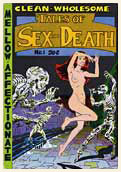|
|
|
Real Pulp Comics #1
 |
|
If you like this comic,
you might
also enjoy |
 |
Tales of Sex and Death |
AVERAGE SCORE 8 |
|
1st-2nd Printing / March 1971 / 36 pages / The Print Mint
 |
Roger Brand's charming and all-too-brief anthology series begins with a wicked little tale featuring The Viper from Art Spiegelman. For the uninitiated, The Viper is a dastardly, amoral miscreant who "comes to the rescue" of people who need rescuing and takes advantage of the situation to satisfy his own perversions. In this story, called "Pop Goes the Poppa," a young boy (about 10) named Eddie kills his father when his pop tries to discipline him. Eddie then sets out to sexually assault his mother, whose screams alert The Viper to rush to the scene.
The Viper breaks through a window to enter their house and proceeds to hold down the mother so Eddie can fuck her. The Viper also helps himself to a blow job while he's at it. After they've both finished with mommy, The Viper shoots her dead to prevent her from talking and then takes the kid out for a beer.
The Viper was the most vile antihero ever modeled after Will Eisner's The Spirit, and it earned the 23-year-old Spiegelman recognition in the underground. He created the character after meeting Robert Crumb, who inspired him to "get in touch with your inner psychopath." Spiegelman's chest may not swell with pride when he looks back on The Viper ("I'm not proud of my Viper period. It was a poor imitation of Eisner...it was a period I went through"), but it was probably something he had to get out of his system. At least it only took him a year or two. It's taken Crumb a lifetime.
Spiegelman's depraved tale is followed by Kim Deitch's "World Weary," which features one of Deitch's signature characters, a black cat named Waldo. In this story, Waldo befriends a very old cat who feels life is over for him, but Waldo takes it upon himself to spice up the old codger's life. The next day they disguise themselves as a man, abduct a high-school girl off the streets and take her back to their house to rape her. When the cops bust onto the scene, the elder cat dies of a heart attack but Waldo manages to escape. After a nightmare that features the dead old cat in Hell, Waldo decides to turn over a new leaf and become a good citizen, but he's caught by the cops and must suffer his punishment anyway.
This thinly veiled morality tale plays out much like a pulp crime story from the old days and has about as much affect on its readers: Crime does not pay, but it sure is a helluva lotta fun while you can get away with it.
A couple pages later, Bill Griffith gives us "I Gave My Heart to a Pinhead and He Made a Fool Out of Me."
The pinhead from the title is, of course, none other than Zippy, who makes his debut in comic books with this "true romance" satire. In the story, Zippy is actually called Danny at the beginning and then Sidney in the middle; both fake names Zippy gave to women he's involved with romantically.
Unbeknownst to Zippy, the two chicks are actually old friends and they coincidentally meet up and learn of their unfaithful lover's two-timing. Yet they both remain madly in love with Zippy and keep on dating him separately. When Zippy finally agrees to decide between the two women, they rush to his house to learn which girl he truly wants, only to learn there's a third woman he's also fucking! Oh, the humiliation!
The Zippy story is one of several spoofs on romance comic tropes that Griffith produced in the early '70s and it's one of his better ones. In the decades that followed, Zippy would come to dominate Griffith's career, which turned out to be most fortunate for him but left some of his old fans pining for more razor-sharp satire from Griffith that didn't feature his world-famous pinhead.
Real Pulp Comics #1 is barely halfway done at the conclusion of the Zippy story. The second half of the book leads off with S. Clay Wilson's violent two-pager about a hyper-violent motorcycle gang, followed by an archetypal romance comic from Joel Beck, who had been buddies with Brand since their high-school days in El Sobrante.
The book concludes with Brand's own "The Floating Head," a bizarre story of a man named Peter Head who survives an awful laboratory explosion with only his head intact, which is kept alive by a scientist. The Floating Head later develops extraordinary telepathic powers and eventually masters the "black arts," which enables him to mentally control everyone he knows (including beautiful women). This also allows him to become extremely rich. The climax of the story involves an honorable old friend who attempts to end the Floating Head's reign of selfish domination, but we learn that it takes more than extensive training in the black arts to become the "Head" of the class.
Real Pulp Comics #1 represents one of the pinnacles of Roger Brand's comic career and delivers a lowbrow menu of stories that proves to be highly entertaining. Yes, it portrays incest, rape, murder and malice against women and children, yet all of it is so outrageous that only a birdbrain could possibly take it seriously.



HISTORICAL FOOTNOTES:
There are two printings of this comic book, both by The Print Mint, and they are considered indistinguishable from one another. Each printing produced approximately 20,000 copies.

COMIC CREATORS:
Roger Brand - editor, 1-2, 27-34
Art Spiegelman - 3-7
Kim Deitch - 8-12
Ron White - 13-14, 36
Bill Griffith - 15-19
S. Clay Wilson - 20-21
Joel Beck - 22-25, 26 (shared), 35
Leslie Cabarga - 26 (shared) |
|
|

































